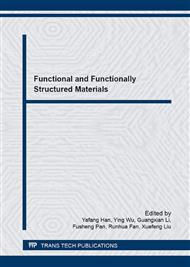[1]
C. -K. Lin, J. -F. Kuo, C. -Y. Chen, Synthesis and mesomorphism of thermotropic liquid crystalline polyurethanes based on meta-diisocyanates with 4, 4'-bis(ω-hydroxyalkoxy) biphenyls, European Polymer Journal, 36 (2000) 1183-1193.
DOI: 10.1016/s0014-3057(99)00164-0
Google Scholar
[2]
M.D. Hager, S. Bode, C. Weber, U.S. Schubert, Shape memory polymers: Past, present and future developments, Progress in Polymer Science.
DOI: 10.1016/j.progpolymsci.2015.04.002
Google Scholar
[3]
L. Peponi, I. Navarro-Baena, A. Sonseca, E. Gimenez, A. Marcos-Fernandez, J.M. Kenny, Synthesis and characterization of PCL-PLLA polyurethane with shape memory behavior, European Polymer Journal, 49 (2013) 893-903.
DOI: 10.1016/j.eurpolymj.2012.11.001
Google Scholar
[4]
J.T. Kim, B.K. Kim, E.Y. Kim, H.C. Park, H.M. Jeong, Synthesis and shape memory performance of polyurethane/graphene nanocomposites, Reactive and Functional Polymers, 74 (2014) 16-21.
DOI: 10.1016/j.reactfunctpolym.2013.10.004
Google Scholar
[5]
H.M. Jeong, B.K. Kim, Y.J. Choi, Synthesis and cationic photopolymerization of biorenewable monomers and oligomers, Polymer, 41 (2000) 1849-1855.
Google Scholar
[6]
S.N. Jaisankar, D.J. Nelson, C.N. Brammer, New synthesis and characterization of ionic polyurethane-urea liquid crystals, Polymer, 50 (2009) 4775-4780.
DOI: 10.1016/j.polymer.2009.07.049
Google Scholar
[7]
Tanaka M, Nakaya T. Kobunshi Ronbunshu 1986; 43: 311.
Google Scholar
[8]
Changhai H, Chaocan Z, Minli X, Shuangqing Z. Synthesis and thermal properties of side-chain liquid crystalline poly[1-({(4-methoxyazobenzene-4'-oxy)alkyl}thio)- 2. 3-epoxypropane]s, Liq Cryst 2008; 35: 1321-8.
DOI: 10.1080/02678290802578447
Google Scholar
[9]
M.M. Rahman, H.D. Kim, W.K. Lee, Properties of waterborne polyurethane adhesives: effect of chain extender and polyol content, J. Adhes. Sci. Technol. 23 (2009) 177-193.
DOI: 10.1163/156856108x344667
Google Scholar
[10]
N. Liu, Y. Zhao, M. Kang, J. Wang, X. Wang, Y. Feng, N. Yin, Q. Li, The effects of the molecular weight and structure of polycarbonatediols on the properties of waterborne polyurethanes, Progress in Organic Coatings, 82 (2015) 46-56.
DOI: 10.1016/j.porgcoat.2015.01.015
Google Scholar
[11]
P. Król, Barbara Pilch-Pitera, Phase structure and thermal stability of crossslinked polyurethane elstomers based on well-defined prepolymers, J. Appl. Polym. Sci. 104(3)(May 2007) 1464-1474.
DOI: 10.1002/app.25011
Google Scholar
[12]
S.M. Cakic, J.V. Stamenkovic, D.M. Djordjevic, I.S. Ristic, Synthesis and degradation profile of cast films of PPG-DMPA-IPDI aqueous polyurethane dispersions based on selective catalysts, Polym. Degrad. Stab. 94 (2009) 2015-(2022).
DOI: 10.1016/j.polymdegradstab.2009.07.015
Google Scholar
[13]
G. Trovati, E.A. Sanches, Neto, S.C., Y.P. Mascarenhas, G.O. Chierice, Characterization of Polyurethane Resins by FTIR, TGA, and XRD, 2009. 1-6.
DOI: 10.1002/app.31096
Google Scholar
[14]
S. Mondal, D. Martin, Hydrolytic degradation of segmented polyurethane copolymers for biomedical applications, Polym. Degrad. Stab. 97(8) (Aug. 2012) 1553-1561.
DOI: 10.1016/j.polymdegradstab.2012.04.008
Google Scholar
[15]
D.K. Lee, H.B. Tsai, H.H. Wang, R.S. Tsai, Aqueous polyurethane dispersions derived from polycarbonatediols, J. Appl. Polym. Sci. 94 (2004) 1723-1729.
DOI: 10.1002/app.21090
Google Scholar
[16]
M. M Rahman, J.H. Kim, H.D. Kim, Characterization of waterbrone polyurethane/clay nanocomposite adhesives containing different amounts of ionic groups, J. Adhes. Sci. Technol. 21 (2007) 1575-1588.
DOI: 10.1163/156856107782793195
Google Scholar
[17]
Ahn TO, Choi IS, Jeong HM, Cho K. Thermal and mechanical properties of thermoplastic polyurethane elastomers from different polymerization methods, Polym Int 1993; 31: 329.
DOI: 10.1002/pi.4990310404
Google Scholar
[18]
L. Fang, G. Han, J. Zhang, H. Zhang, H. Zhang, European Polymer Journal.
Google Scholar
[19]
C. Fang, X. Zhou, Q. Yu, S. Liu, D. Guo, R. Yu, J. Hu, Progress in Organic Coatings, 77 (2014) 61-71.
Google Scholar
[20]
M. Raja, S.H. Ryu, A.M. Shanmugharaj, Thermal, mechanical and electroactive shape memory properties of polyurethane (PU)/poly (lactic acid) (PLA)/CNT nanocomposites, European Polymer Journal, 49 (2013) 3492-3500.
DOI: 10.1016/j.eurpolymj.2013.08.009
Google Scholar


